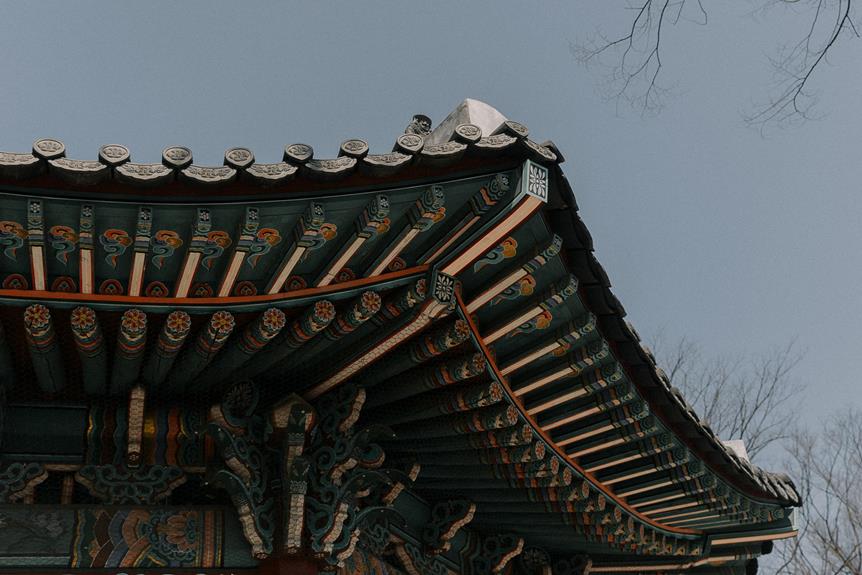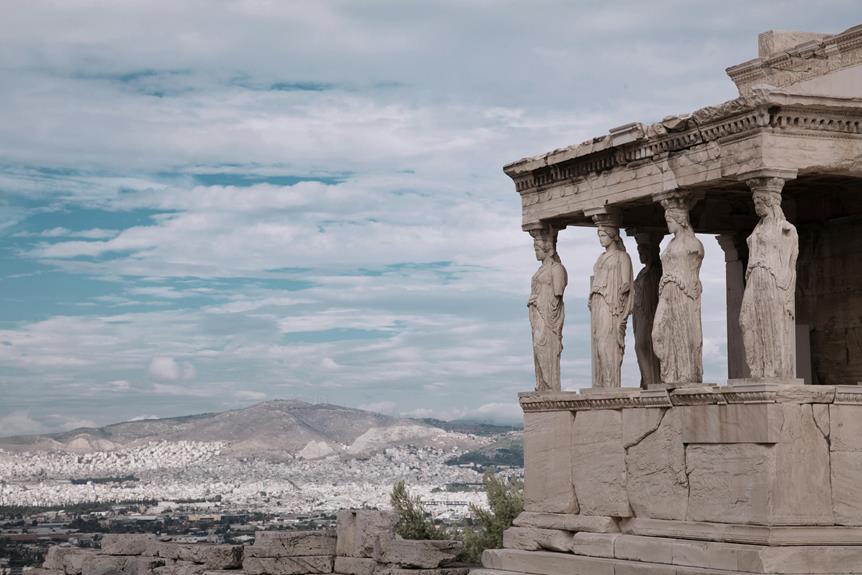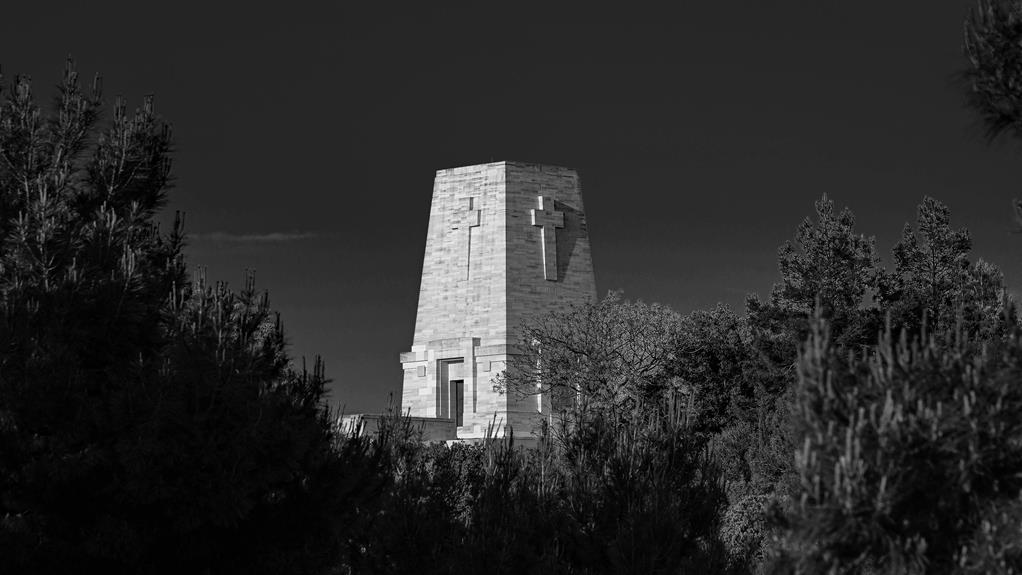Nestled in the heart of Hiroshima, Japan, lies the solemn Hiroshima Peace Memorial Park—a site that beckons visitors to reflect on the catastrophic events of history. As visitors traverse the park's grounds, they are met with a profound sense of somber contemplation, confronted by the enduring proof of the perils of war. The park's poignant A-Bomb Dome stands as a silent witness to the past, its presence evoking a multitude of emotions and stirring a deep-seated curiosity about the stories it holds within its walls.
Key Takeaways
- Symbolizes impact of atomic bombings in WWII.
- A-Bomb Dome represents resilience and hope.
- Peace Memorial Museum documents 1945 events.
- Annual Peace Memorial Ceremony honors victims.
- Promotes peace, reconciliation, and nuclear disarmament.
History of Hiroshima Peace Memorial Park
What events led to the establishment of the Hiroshima Peace Memorial Park, symbolizing the devastating impact of nuclear warfare on humanity? Following the end of World War II, Hiroshima found itself at the center of one of the most tragic events in human history – the atomic bombings of Hiroshima and Nagasaki by the United States in August 1945. The city of Hiroshima was left in ruins, with thousands dead and many more suffering from the horrific effects of radiation. In the aftermath of such destruction, Hiroshima began its arduous reconstruction efforts, aiming to rebuild not only its physical structures but also its spirit and resilience.
As part of these reconstruction efforts, the idea of creating a memorial park to commemorate the victims of the atomic bombings and to promote peace and understanding gained traction. The Hiroshima Peace Memorial Park was established to serve as a poignant reminder of the catastrophic consequences of nuclear warfare and to advocate for a world free from such atrocities. The park encompasses various monuments, including the iconic A-Bomb Dome, which stands as a haunting symbol of the destructive power of nuclear weapons.
Through the Hiroshima Peace Memorial Park, the city of Hiroshima honors the memory of the victims while also endeavoring to educate future generations about the importance of working towards a peaceful world, free from the horrors of war and nuclear proliferation.
Significance of A-Bomb Dome
The A-Bomb Dome in Hiroshima Peace Memorial Park stands as a stark and poignant reminder of the devastating impact of nuclear warfare on humanity, embodying both the physical destruction and the enduring call for peace and remembrance. Originally known as the Hiroshima Prefectural Industrial Promotion Hall, the A-Bomb Dome was one of the few buildings near the hypocenter of the atomic bomb explosion on August 6, 1945, to remain at least partially standing. Its haunting skeletal structure serves as a symbol of resilience, urging visitors to contemplate the horrors of war and the importance of working towards a peaceful world.
Deeper Meaning:
- Architecture Preservation: The A-Bomb Dome's preservation in its ruined state symbolizes the resilience of the human spirit amidst destruction, emphasizing the importance of preserving historical sites as poignant reminders of the past.
- Global Awareness: Its recognition as a UNESCO World Heritage Site highlights the global significance of the A-Bomb Dome, fostering awareness of the catastrophic consequences of nuclear warfare and the imperative for international cooperation to prevent such tragedies in the future.
- Symbol of Hope: Despite its tragic history, the A-Bomb Dome stands as a symbol of hope, calling for a world free from nuclear weapons and advocating for peace, reconciliation, and remembrance on a global scale.
Exhibits at Peace Memorial Museum
Within the somber halls of the Peace Memorial Museum, a myriad of exhibits meticulously document the harrowing events of August 6, 1945, and their lasting impact on Hiroshima and the world. The museum stands as a poignant reminder of the catastrophic effects of the atomic bomb dropped on Hiroshima during World War II. Visitors are guided through a detailed journey, starting with the events leading up to the bombing, the devastation caused by the bomb, and the stories of resilience and survival in its aftermath.
One of the most powerful exhibits is the collection of personal belongings and artifacts that belonged to the victims of the atomic bomb. These items, ranging from clothing to children's toys, serve as tangible reminders of the lives lost and the human toll of war. The museum also features detailed accounts of survivors' stories, providing a firsthand look at the experiences of those who lived through the bombing and its aftermath.
Additionally, the Peace Memorial Museum houses a wealth of historical documents, photographs, and videos that offer a thorough look at the impact of the atomic bomb on Hiroshima and its people. Through these exhibits, visitors are able to gain a deeper understanding of the tragic events of August 6, 1945, and reflect on the importance of peace and reconciliation in a world scarred by conflict.
Hiroshima Peace Memorial Ceremony
Each year on August 6th, the Hiroshima Peace Memorial Ceremony solemnly commemorates the victims of the atomic bombing and advocates for a world free of nuclear weapons. This ceremony serves as a poignant reminder of the devastating impact of war and the importance of working towards peace.
Here are three key aspects that enrich the significance of the Hiroshima Peace Memorial Ceremony:
- Survivor Stories and Peacebuilding: The ceremony often features survivors of the atomic bombing sharing their harrowing experiences, emphasizing the resilience of the human spirit in the face of adversity. These stories not only honor the memory of the victims but also inspire a collective commitment to peacebuilding efforts aimed at preventing such tragedies from recurring.
- Global Remembrance and Nuclear Disarmament: Through this ceremony, Hiroshima extends a message of global remembrance, urging nations worldwide to reflect on the horrors of nuclear warfare. By highlighting the catastrophic consequences of nuclear weapons, the ceremony advocates for nuclear disarmament and promotes dialogue towards a world free from the threat of nuclear devastation.
- Symbol of Hope and Unity: The Hiroshima Peace Memorial Ceremony symbolizes hope for a better future and serves as a unifying force for people around the world who seek a peaceful coexistence. It stands as a beacon of light, guiding humanity towards a path of reconciliation, understanding, and a shared commitment to building a more peaceful world.
Importance of Peace Education
An integral component in fostering a culture of peace and cultivating a mindset of conflict resolution is the emphasis on peace education. Peace education plays a pivotal role in promoting values of tolerance, understanding, and empathy, essential for building a more peaceful and harmonious world. By educating individuals on the importance of global citizenship, peace education encourages a sense of belonging to a wider community beyond national borders. It instills in people a sense of responsibility towards promoting peace and addressing conflicts at both local and international levels.
Furthermore, peace education equips individuals with the necessary skills and knowledge to resolve conflicts peacefully. Through conflict resolution training, individuals learn effective communication, negotiation, and mediation techniques that are essential in managing disputes without resorting to violence. By fostering a deep understanding of the root causes of conflicts, peace education empowers individuals to address underlying issues and work towards sustainable solutions.
In the context of Hiroshima Peace Memorial Park, peace education is particularly significant as it conveys the powerful message of resilience, forgiveness, and reconciliation in the face of immense suffering. By educating visitors about the devastating consequences of nuclear warfare and the importance of peacebuilding efforts, Hiroshima exemplifies the transformative power of peace education in shaping a more peaceful world.
Impact of Hiroshima's Message
The legacy of Hiroshima's message resonates globally, profoundly impacting perspectives on peace, conflict, and the enduring consequences of nuclear warfare. The remembrance of the atomic bombings of Hiroshima and Nagasaki in 1945 serves as a poignant reminder of the devastating impact of war and the importance of working towards peace.
The Hiroshima Peace Memorial Park stands as a symbol of hope, reconciliation, and a commitment to a world free from nuclear threats. Here are three key aspects that highlight the profound impact of Hiroshima's message:
- Promotion of Peace: Hiroshima's message emphasizes the necessity of promoting peace through dialogue, understanding, and cooperation among nations. It serves as a call to action to prevent future conflicts and advocate for peaceful resolutions to global disputes.
- Nuclear Disarmament: The legacy of Hiroshima underscores the urgent need for nuclear disarmament to prevent catastrophic humanitarian crises. It urges nations to work towards reducing and eventually eliminating nuclear weapons to safeguard the security and well-being of present and future generations.
- Global Solidarity: The remembrance of Hiroshima fosters a sense of global solidarity, encouraging individuals, communities, and governments worldwide to unite in the pursuit of peace, justice, and reconciliation. It highlights the interconnectedness of humanity and the shared responsibility to protect the planet and its inhabitants from the horrors of war.
Frequently Asked Questions
How Can Visitors Contribute to Promoting Peace at the Park?
Visitors can contribute to promoting peace at the park through various means. They can explore donation opportunities to support the park's initiatives and maintenance.
Additionally, engaging in volunteer programs allows visitors to actively participate in the preservation and promotion of peace within the park.
Are There Any Specific Guidelines for Paying Respect at the A-Bomb Dome?
Proper etiquette and adherence to cultural norms are essential when paying respect at a site like the A-Bomb Dome. Visitors should maintain a solemn and respectful demeanor, refraining from loud noises, inappropriate behavior, or any actions that may be perceived as disrespectful.
It is customary to bow or offer a moment of silence as a sign of reverence. Following these guidelines demonstrates sensitivity to the historical significance and honors the memory of those affected by the tragic event.
What Initiatives Does the Park Undertake to Support Peace Education?
Peace education initiatives are essential for fostering understanding and empathy. Educational programs, interactive exhibits, and visitor engagement opportunities are common strategies employed to promote peace education.
Cultural exchange programs further enhance global perspectives. Peace memorials serve as poignant reminders of the importance of learning from the past to build a more peaceful future.
Initiatives like these at parks and memorial sites worldwide play an important role in promoting peace and reconciliation.
Can Visitors Participate in the Hiroshima Peace Memorial Ceremony?
Visitor etiquette is vital when participating in the Hiroshima Peace Memorial Ceremony. To engage respectfully, visitors should adhere to the designated dress code, maintain silence during solemn moments, and follow the guidance of ceremony organizers.
Participation typically involves observing a moment of silence, laying flowers or origami cranes at the memorial, and reflecting on the importance of peace. Understanding the significance of the ceremony and showing reverence are essential aspects of visitor participation.
How Has the Message of Hiroshima Influenced Global Peace Movements?
The message of Hiroshima, stemming from a tragic history, has had a profound impact on global peace movements. Its harrowing events serve as a stark reminder of the devastating consequences of war and the urgent need for peace education.
The lessons learned from Hiroshima have inspired individuals and organizations worldwide to advocate for peace, promote non-violence, and work towards a more harmonious and peaceful world for future generations.
Conclusion
To sum up, Hiroshima Peace Memorial Park stands as a beacon of hope and a stark reminder of the devastating consequences of war.
Like a phoenix rising from the ashes, it symbolizes resilience, unity, and the pursuit of peace.
The park's message echoes like a gentle breeze, urging us to learn from the past, endeavor for understanding and cooperation, and work towards a future free from the horrors of nuclear conflict.


